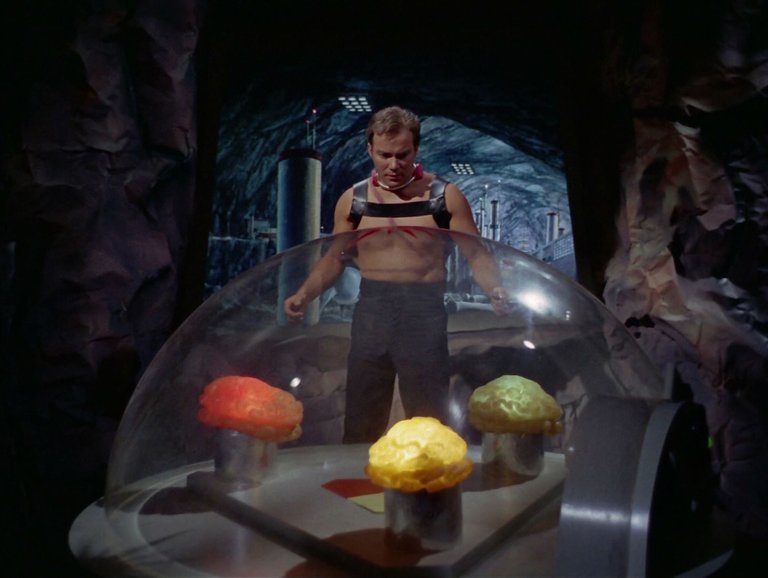Television Review: The Gamesters of Triskelion (Star Trek, S2X17, 1968)

The Gamesters of Triskelion (S02E17)
Airdate: January 5th 1968
Written by: Margaret Arman
Directed by: Gene Nelson
Running Time: 50 minutes
The second season of Star Trek: The Original Series (TOS) is widely celebrated as the pinnacle of the franchise’s initial run, a period that crystallised the show’s identity through episodes like The Trouble with Tribbles. Yet, this same season also sowed the seeds of a gradual, contentious decline—a descent not marked by overt failure but by a creeping prioritisation of spectacle over substance. Among the contenders for the episode that signalled this shift, The Gamesters of Triskelion emerges as a compelling, if flawed, case study. While undeniably entertaining, this instalment diverges from the cerebral ambition of TOS’s early classics, opting instead for a formula steeped in exploitation tropes and camp theatrics, thereby epitomising the uneasy balance between innovation and decadence that would increasingly define the series.
The narrative begins with a routine mission during which Captain Kirk, Chekov, and Uhura unexpectedly materialise on planet Triskelion. Their abduction—orchestrated by the alien Providers, who redirect the transporter beam—plunges them into a dystopian arena where abducted beings are reduced to “thraals,” enslaved gladiators forced to fight for the Providers’ amusement. The trio’s collars, which deliver agonising shocks to enforce obedience, frame the story’s central conflict: survival under a regime of corporeal punishment. Yet the Providers’ true malevolence lies not in their cruelty but in their decadence. These disembodied entities, having transcended physicality, derive thrills solely from gambling on the outcomes of combat—a conceit that positions them as parodies of imperial decadence, their omnipotence rendered hollow by their fixation on voyeuristic entertainment. To prepare the protagonists for the arena, the Providers assign them “drill thraals”—fellow slaves tasked with training them. Here, the episode’s most overtly provocative element emerges: the drill thraals, including Shahna (Angelique Pettyjohn), are of the opposite sex to their trainees. Shahna, clad in a revealing costume that accentuates her physique, becomes the object of Kirk’s flirtatious advances, a dynamic that foreshadows the episode’s preoccupation with sexualised subtext.
At first glance, The Gamesters of Triskelion risks accusations of derivative storytelling, echoing the gladiatorial motifs of Season 1’s Arena, where Kirk battles the Gorn for the amusement of the Metrons. However, Margaret Arman’s script introduces distinctions that elevate the premise beyond mere repetition. By expanding the cast of enslaved characters to include Chekov and Uhura, Arman broadens the scope of the Providers’ tyranny, allowing for interplay between the trio as they navigate the alien hierarchy. The arena itself straddles the familiar and the alien: its architecture and combat rituals nod to Roman antiquity, grounding the spectacle in Earth’s historical imagination, while the Providers’ ethereal presence—a disembodied voice and a hovering, geometric symbol known as the Triskelion—underscores their otherness. The Providers’ moral bankruptcy, meanwhile, is laid bare in their regression from corporeal beings to passive gamblers, a critique of hedonism that mirrors the decadence of historical empires that collapsed under the weight of their own indulgence.
Yet these thematic undercurrents are overshadowed by the episode’s embrace of exploitation cinema tropes, a stark departure from the family-friendly ethos of earlier entries like The Trouble with Tribbles. The title’s nod to Pauline Réage’s Story of O—a 1954 pornographic novel featuring a Triskelion, a symbol used by BDSM secret society—is no coincidence. Shahna’s attire, a minimalist ensemble that accentuates Pettyjohn’s figure, veers into soft-core territory, a choice that aligns with her later career in burlesque and pornography. Kirk’s shirtless duels and frequent whipping, juxtaposed with Uhura’s relative underuse as a character, cater to fan service, reducing the episode’s crude spectacle of sexual objectification. This shift toward adult-oriented content reflects the series’ uneasy negotiation with network constraints; while TOS had previously navigated censorship through allegory, The Gamesters of Triskelion courts controversy by leaning into titillation, sacrificing nuance for visual provocation.
Despite its exploitative leanings, the episode is not without merit. Jane Ross’s portrayal of Chekov’s drill thraal injects unexpected levity, as the Russian officer stumbles through awkward romantic overtures, his bewilderment amplifying the absurdity of the situation. Gene Nelson’s direction, though uneven, delivers moments of visual flair: the arena’s stark lighting and the Providers’ abstract control room evoke a stark, sterile tyranny. The fight choreography, initially laughable in its lack of conviction, gains tension in the climactic duel between Kirk and Shahna, where the stakes of Kirk’s gambit—to wager his life for the freedom of all thraals—lend urgency to the combat. The resolution, wherein Kirk outwits the Providers by appealing to their gambling instincts, offers a satisfying twist, privileging intellect over brute force. This cerebral conclusion, however, feels at odds with the episode’s preceding indulgences, as if Arman and Nelson could not fully reconcile the demands of subtext with the allure of spectacle.
Ultimately, The Gamesters of Triskelion is as a polarising entry in the TOS canon—a work of contradictions that oscillates between critique and complicity. Its exploration of exploitation, both systemic and sexual, is undercut by its own voyeuristic tendencies, rendering its moral stance ambiguous. For many fans, it functions as a guilty pleasure, a campy, occasionally risqué detour that contrasts sharply with the philosophical rigor of the series’ golden age. Yet its legacy is telling: the episode’s focus on skin, spectacle, and sensation foreshadows the declining ratings and creative fatigue that would plague later seasons, marking it as a pivotal, if regrettable, waypoint in Star Trek’s evolution. In this light, The Gamesters of Triskelion is less a triumph than a cautionary tale—a reminder that even the most visionary franchises are vulnerable to the seduction of easy thrills.
RATING: 6/10 (++)
Blog in Croatian https://draxblog.com
Blog in English https://draxreview.wordpress.com/
InLeo blog https://inleo.io/@drax.leo
LeoDex: https://leodex.io/?ref=drax
InLeo: https://inleo.io/signup?referral=drax.leo
Hiveonboard: https://hiveonboard.com?ref=drax
Rising Star game: https://www.risingstargame.com?referrer=drax
1Inch: https://1inch.exchange/#/r/0x83823d8CCB74F828148258BB4457642124b1328e
BTC donations: 1EWxiMiP6iiG9rger3NuUSd6HByaxQWafG
ETH donations: 0xB305F144323b99e6f8b1d66f5D7DE78B498C32A7
BCH donations: qpvxw0jax79lhmvlgcldkzpqanf03r9cjv8y6gtmk9